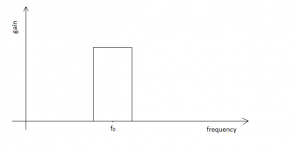This set of Instrumentation Transducers Interview Questions and Answers for freshers focuses on “Filtering and Dynamic Compensation”.
1. Which of the following is true for ideal filter frequency response?
a) Abrupt change from pass band to reject band
b) Smooth change from pass band to reject band
c) Contains only pass band
d) None of the mentioned
View Answer
Explanation: An ideal filter shows ideal performance and change from pass band to reject band occurs abruptly.
2. Which of the following is true for low-pass filter?
a) Pass band less than cut-off frequency
b) Pass band greater the cut-off frequency
c) Pass band anywhere in frequency response
d) None of the mentioned
View Answer
Explanation: A low-pass filter means, which passes all frequencies less than cut-off frequency. That is pass band will be less than cut-off frequency.
3. Identify the frequency response?

a) Low pass filter
b) High pass filter
c) Band pass filter
d) Band reject filter
View Answer
Explanation: Given frequency response passes a definite band of frequency and surely it is a band pass filter.
4. Which of the following represents bridge-T filter?
a) Band pass filter
b) Low pass filter
c) High pass filter
d) Band reject filter
View Answer
Explanation: Bridge-T filters reject a specific band of frequency and allow other frequencies to pass through. Hence it is a band reject filter.
5. Twin-T filter is band reject and Notch filter is band pass filter.
a) True
b) False
View Answer
Explanation: Twin-T filter itself is called as Notch filter, they are band reject filters.
6. Notch filter belongs to _________________
a) Zero-order system
b) First-order system
c) Second-order system
d) Third-order system
View Answer
Explanation: Notch filter transfer function is a very complex one and contains higher order of three.
7. Rejection frequency of notch filter can be expressed as _________________
a) 1/RC
b) 1/C
c) 1/R
d) Unpredictable
View Answer
Explanation: Rejection frequency is the range of frequency rejected by filter, it is on applicable if R1=R2 and C1=C2.
8. Which of the following statement is true?
a) Lead network is composed of capacitor only
b) Lag network is composed of inductor only
c) Lead network is composed of resistance only
d) Lead network and lag network is composed of resistance and capacitor
View Answer
Explanation: Lead network, lag network are composed of resistance and capacitive components using different configurations.
9. Tuned LCR circuit forms band-pass filters.
a) True
b) False
View Answer
Explanation: Tuned LCR circuit in series and parallel combination allows a specific band of frequency to pass through and is band pass filter.
10. Why dynamic compensation is used?
a) To increase pass band
b) To increase cut off frequency
c) To improve dynamic performance
d) None of the mentioned
View Answer
Explanation: Dynamic compensation is used for improving dynamic performance of the system, it is achieved by proper selection of resistance and use of amplifiers to reduce the effect of losses.
Sanfoundry Global Education & Learning Series – Instrumentation Transducers.
To practice all areas of Instrumentation Transducers for Interviews, here is complete set of 1000+ Multiple Choice Questions and Answers.
If you find a mistake in question / option / answer, kindly take a screenshot and email to [email protected]
- Apply for Instrumentation Engineering Internship
- Practice Instrumentation Engineering MCQs
- Check Instrumentation Engineering Books
- Check Instrumentation Transducers Books
